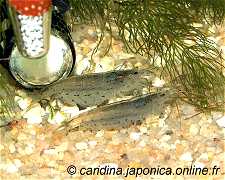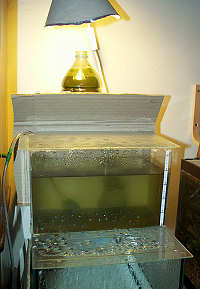1) My equipment
 - The hatching tank :
- The hatching tank :
It is important to have the females hatch the larvae in a separate tank, otherwise they will be eaten in a matter of hours, and will be impossible to catch. I use an old 4.5 gallon tank to keep my gravid females until they hatch their larvae. The tank has been emptied of all equipment except from a small 11W heater which maintain its water at the same temperature as the main tank the shrimps are from. It is not strictly necessary, but before putting the females in this tank you may change half of its water with water from their tank of origin. Of course, this tank is 100% freshwater : adult caridina japonica do not tolerate saltwater ! (I have to mention this, since I still get questions on this matter) Once the larvae (which are also called "zoes") are hatched, you can siphon them out to put them in the breeding tank, and put the females back in the main tank. Since the hatching tank has no filtration, I feed them as little as possible so as not to pollute the water too much : that is why I do not transfer them into this tank until the very last moment (during the week before hatching).
- The breeding tank :
 Given the size of the larvae, no need for a lot of water, so my small 5L (1 gallon) acrylic tank is largely enough. This tank is full of seawater at 33/34ppm salinity in which I cultivate marine phytoplancton alagae Dunalliela Salina. The light necessary for the phytoplancton is provided by a small 15W fluocompact lamp. Any kind of fluorescent lighting will do, mine is a standard 2700K for domestic use. The light has to be kept on 24/24hrs, or else, for reasons as yet unknown, a significant number of larvae die if you switch it off at night.
Given the size of the larvae, no need for a lot of water, so my small 5L (1 gallon) acrylic tank is largely enough. This tank is full of seawater at 33/34ppm salinity in which I cultivate marine phytoplancton alagae Dunalliela Salina. The light necessary for the phytoplancton is provided by a small 15W fluocompact lamp. Any kind of fluorescent lighting will do, mine is a standard 2700K for domestic use. The light has to be kept on 24/24hrs, or else, for reasons as yet unknown, a significant number of larvae die if you switch it off at night.
Not much equipment either, just a tiny air stone with minimum airflow to keep water flowing inside the tank and prevent the formation of a surface film. The cardboard sheet behind the tank is just here to create a uniform dark background which enables me to make out the larvea more easily.
This tank was started well before the birth of the larvae, to allow for the chemical balance in the water to settle, and also to let the algae culture develop. For this purpose, When starting the tank I added a small stock of marine phytoplancton (greenish seawater) as well as fertilizer (a few drops per Liter) in order to start the phytoplancton culture. After a few days the water took a dark green coloration due to the algae. This allowed me to breed my larvae without having to feed them with any additional food, thus no organic pollution and no need to change water frequently.
|
|

